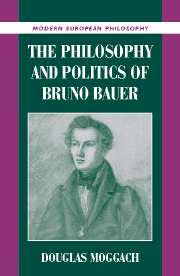Book contents
- Frontmatter
- Contents
- Preface
- THE PHILOSOPHY AND POLITICS OF BRUNO BAUER
- Introduction: “The Friend of Freedom”
- I FOUNDATIONS: AESTHETICS, ETHICS, AND REPUBLICANISM
- II JUDGING THE OLD ORDER
- III THE EMANCIPATORY PROJECT
- 5 “Only the Ought Is True”: Hegel, Self-Consciousness, and Revolution
- 6 “To the People Belongs the Future”: Universal Right and History
- IV JUDGING THE REVOLUTIONARY MOVEMENT
- Epilogue: After the Revolution: The Conclusion of the Christian-Germanic Age
- Appendix: Bruno Bauer, “On the Principles of the Beautiful” (1829)
- Notes
- Bibliography
- Index
6 - “To the People Belongs the Future”: Universal Right and History
Published online by Cambridge University Press: 05 June 2012
- Frontmatter
- Contents
- Preface
- THE PHILOSOPHY AND POLITICS OF BRUNO BAUER
- Introduction: “The Friend of Freedom”
- I FOUNDATIONS: AESTHETICS, ETHICS, AND REPUBLICANISM
- II JUDGING THE OLD ORDER
- III THE EMANCIPATORY PROJECT
- 5 “Only the Ought Is True”: Hegel, Self-Consciousness, and Revolution
- 6 “To the People Belongs the Future”: Universal Right and History
- IV JUDGING THE REVOLUTIONARY MOVEMENT
- Epilogue: After the Revolution: The Conclusion of the Christian-Germanic Age
- Appendix: Bruno Bauer, “On the Principles of the Beautiful” (1829)
- Notes
- Bibliography
- Index
Summary
After the pseudo-pietistic hysteria of the Posaune, Bauer's texts of late 1841 to mid-1842 analyse the concrete political and ideological conjuncture. They also examine further the relation between autonomous consciousness and the forms of its historical genesis, particularly the Enlightenment and the French Revolution. Bauer depicts the Revolution as the struggle for the emancipation of self-consciousness, and probes its connection to the progressive movement in Germany. He clarifies his relation to Hegel. Renouncing the ironic guise of the Posaune, he now explicitly argues what he had stated privately in his earlier correspondence, that Hegel's doctrine of Absolute Spirit retains elements of transcendence, antithetical to the claims of autonomy. Yet he continues to defend the Hegelian system and its progressive orientation, both against Hegel's own defective execution of his principles, and against the criticisms and attempted appropriations by the conservative forces. With the Posaune, Bauer's theoretical system is essentially complete. The problematics of thought and being, and of ethical idealism, remain the determining context of reflection in the subsequent period. The texts of 1841–42 offer elaboration and clarification, but no fundamentally new departures. They do, however, make manifest tensions in Bauer's conception of the revolutionary process, which have significant theoretical consequences. The publications can be grouped into three categories: two books, eighteen journalistic articles, and six theoretical essays.
In his anonymous continuation of the Posaune, entitled Hegels Lehre von der Religion und Kunst (Hegel's Doctrine of Religion and Art), written between December 1841 and February 1842 and published on June 1, 1842, Bauer demonstrates the connection between Hegel's critique of religion and of the state.
- Type
- Chapter
- Information
- The Philosophy and Politics of Bruno Bauer , pp. 119 - 136Publisher: Cambridge University PressPrint publication year: 2003



